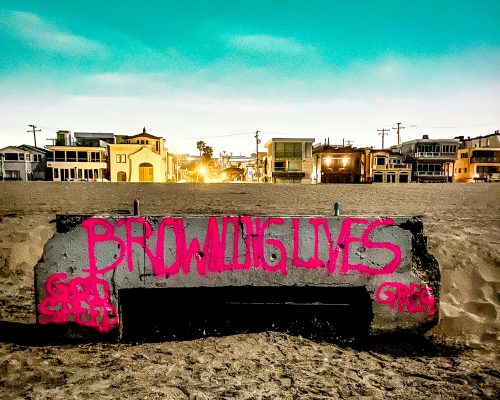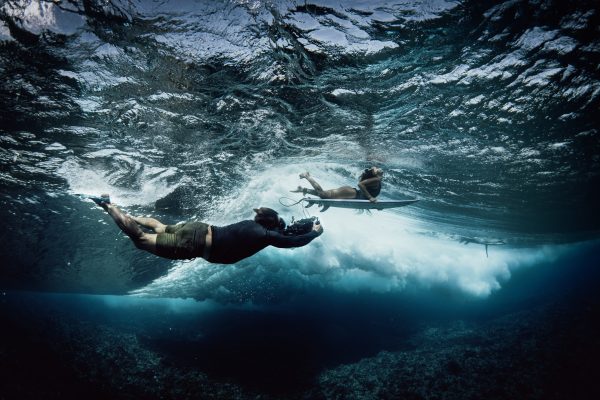by Wrigley Zbyszewski
The local volleyball community and the County of Los Angeles are at odds over the color orange.
Over the past year, two scenes have replayed several times at the volleyball court at Marine Street in Manhattan Beach. In one, a County truck pulls up, and workers get out and paint the volleyball court’s orange poles white. In the other scene, usually in the early mornings, a local arrives at the beach on foot, with a ladder, and repaints the poles orange.
This is the ongoing battle of the Orange Court, so called because this court
historically has had orange-painted posts. While artwork and new coats of paint may have touched the other courts, Manhattan locals and volleyball-related organizations have made efforts to keep the Orange Court, well, orange.
Chris Brown, a well-decorated longtime beach volleyball player who is now president of the California Beach Volleyball Association (CBVA), said that the Orange Court is arguably the most historically significant court in the history of beach volleyball.
“Years ago, the courts were always painted different colors,” said Brown. “Instead of numbering them, you would be on a blue court. You’re on a green court. And then there was the Orange Court. The Orange Court was the main, biggest court throughout the seventies, eighties, and nineties especially. It was the absolute epicenter of the sport anywhere in the world.”
Brown, in a series of emails exchanged with L.A. County officials last year, tried to convey this historical importance.
“It’s akin to Fenway Park in baseball or Augusta National in golf,” Brown wrote. “There are certain locations that carry a special significance. Marine Street in general and the Orange Court in particular carry that same importance to the sport of beach volleyball.”
Brown was part of an effort to convince LA County to keep the Orange Court orange that included Councilperson Steve Napolitano, who is also a beach volleyball player, and local resident Bette Mower, another longtime local player and beach volleyball enthusiast.
Napolitano, who was serving his rotation as mayor at the time, put in an official request on behalf of the City that the court be repainted orange.
It’s called the “Orange Court” because, well, it’s always been painted orange and that’s where all the top players used to play, especially Hov [Tim Hovland] and [Mike] Dodd,” Napolitano wrote. “…Apparently the locals and County crews have been trading paint jobs. County comes in and paints it white and then the locals paint it orange and then it goes round and round. The folks who paint it orange say that past maintenance folks at the County had agreed to let is stay orange but then some other County person would come in and say it needs to be painted white. So in my now official capacity as Mayor, I’m putting in a request to work this out and let the locals keep one court painted orange.”
Carol Baker, deputy director of the County of Los Angeles Department of Beaches and Harbors, questioned Napolitano’s reasoning.
“Why should the court be painted orange?” she responded. “We’re unclear about the color’s significance, and it doesn’t appear that there’s much of a public understanding about what the orange color symbolizes or represents.”
Baker also took issue with the notion that the Orange Court should remain so due to who played there.
“What about other well-known volleyball players from the South Bay?” she wrote. “You mentioned that the court should be painted orange in recognition of players Tim Hovland and Mike Dodd from the 1970’s, but there are other well-known beach players from the South Bay, where Misty May and Kerry Walsh also played. In fact, for general beachgoers, May and Walsh are probably more well recognized than Hovland/Dodd. We’re concerned that specially painting a court…,because Hovland and Dodd frequented that court would raise concerns about other athletes, including Olympians who are more current household names in their sport, and their own ‘go-to’ courts, being overlooked.”
Orange Court advocates argue that this isn’t about just Hovland and Dodd but a long lineage of the sport’s greats. For decades, legendary volleyball players and Olympians set foot on the Orange Court sands for spectators from all around the South Bay to see. Among the list of Orange Court-goers were former beach volleyball Olympian and gold medalist, Eric Fonoimoana, and Olympic gold medalist Alix Klineman.
“It [Marine Street] was one of the main places where the sport was really nurtured in its infancy and grew to what it is today, which is one of the most popular sports in the world, an Olympic sport, and one that NCAA sanctions for scholarships,” Brown said. “This huge monster of club volleyball and recreational volleyball is here now, and we’re lucky enough to have this place that played a big part in that. All they’re trying to do is just maintain just a little bit of their culture by keeping it painted orange as it’s always been.”
County workers have come in several times over the years to paint the other multi-colored courts white, which didn’t create a stir within the volleyball community. But over the pandemic, those Orange Court posts were finally coated in white, and this did create a stir. According to Mower, locals reached out to LA County Supervisor Janice Hahn’s office, who assured the volleyball community the courts would remain orange. But shortly thereafter, Hahn jurisdiction shifted due to redistricting, and the white paint returned. Locals decided to take matters into their own hands.
“We repainted orange. County repainted white. We repainted…I have lost count how many times this cycle continued,” Mower said. “We finally asked Steve Napolitano to contact County and get clarification on their position. They responded but clearly did not understand the situation…We were hoping we could reach a workable solution.”
“I can only think of a 1,000 or so higher priority items for Beaches and Harbors to address before having to repeatedly paint two poles that aren’t doing anyone any harm,” Napolitano said.
In April, Mower again attempted to go through official channels. She had an email exchange with Kenneth Foreman, chief of LA County’s Department of Beach and Harbor’s operational division, which oversees court maintenance.
“I reviewed the attachments, links, and comments that you provided and, though I understand some of the nostalgic feelings associated with the courts, we are unable to authorize painting of the volleyball posts,” Foreman wrote. “The local residents and players may have painted the posts in the past without being approached but the activity occurred without the County’s expressed permission. We cannot allow members of the public to alter the volleyball posts or nets even if their intentions are considered harmless. Unauthorized work on any County property puts the public at risk and, therefore, requires a permit.”
Mower requested a permit but as yet has received no response.
Napolitano noted that neighboring Hermosa Beach, who maintain control of their own beaches, have multicolored volleyball courts and encounter no resulting problems.
“Hermosa’s volleyball courts are all different colors and everything is fine,” he said. “It’s pride of place. All the courts in Manhattan Beach were once painted different colors, and people still could challenge to get games in, and nobody made a big deal out of it. Why someone thinks all white means it’s better for all, I don’t get.”
The Orange Court’s history, Napolitano said, is a cornerstone of local beach culture.
“It’s been host to many tournaments, from early day opens to triple A’s and lower tournaments, and it always had the most competitive mixed tournament of any beach anywhere,” he said. “And the finals would always be held on the same court all the pros practiced at — the Orange Court… It was the court, not just in Manhattan Beach, but in volleyball in general for many, many years, and it is fondly remembered by anyone who has played the game. It’s tradition.”
Though the future of the Orange Court remains uncertain, its legacy remains the same.
“This is a really important spot in the sport,” said Brown. “And this goes way, way back before records were even kept, and we know it was painted orange back in the early sixties, and we don’t know how far before that it even goes. It’s no harm to anyone. It’s just this cool kind of quirk of our culture.”
“The idea that two wood poles planted on the beach means this much to so many people should be celebrated, not whitewashed into nothingness,” Napolitano said. “Let orange be the new white.” ER









